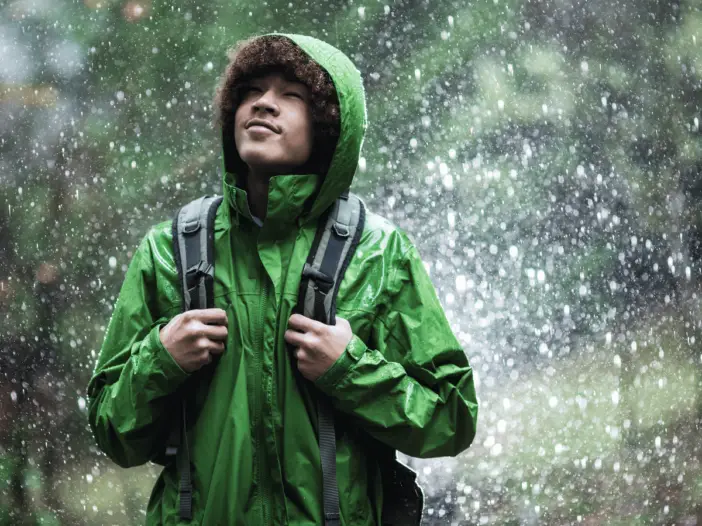
Hiking Tips
Hiking in the rain can be a miserable experience if you are ill-prepared. Follow the tips in this article and make wet weather experiences memorable ones
A Guide to Hiking in the Rain
Have you ever considered going for a hike on a rainy day? While it may seem daunting, hiking in the rain can be an enriching experience. The sound of the rain, the lush greenery, and the fresh air all come together to create a one-of-a-kind adventure.
In this article, we’ll cover 11 essential tips for hiking in the rain, from checking the weather forecast to using trekking poles. With these tips, you’ll be ready to take on any rainy day hike and make some unforgettable memories.
1. Check the Weather Forecast
Take the time to check the forecast, including hourly updates. While it may seem obvious, you don’t want to overlook this step and get caught in a downpour unprepared. Remember that weather forecasting is not an exact science, so it’s always better to over-prepare.
When checking the forecast, pay attention to the expected temperature, wind speed, and chance of precipitation. This information will help you determine what type of clothing to wear and what gear to bring.
It’s also important to note that different trails may have varying weather conditions. If you plan on hiking a track through higher elevations, the temperature and chance of precipitation may differ from those at lower elevations. Keep this in mind when checking the weather forecast and choosing your trail.
Overall, checking the weather forecast before hiking can save you from a soggy and uncomfortable experience. Stay informed and be prepared so that you can enjoy the beauty of hiking in the rain without any unnecessary hiccups.
2. Choose an Appropriate Wet-Weather Trail
Consider the Terrain
When choosing a trail for rainy weather, it’s important to consider the terrain you’ll be hiking on. Different types of terrain can have varying effects on the difficulty and safety of your hike during rainy weather.
For example, if you’re planning a hike that involves steep inclines or declines, avoid these types of trails during wet conditions. Not only can it be dangerous, but it can also cause erosion and damage to the path.
On the other hand, hiking on a path with rocky terrain can provide better traction, making it easier to navigate wet and slippery conditions. Consider the type of terrain you’ll be hiking on and how it may impact your overall experience.
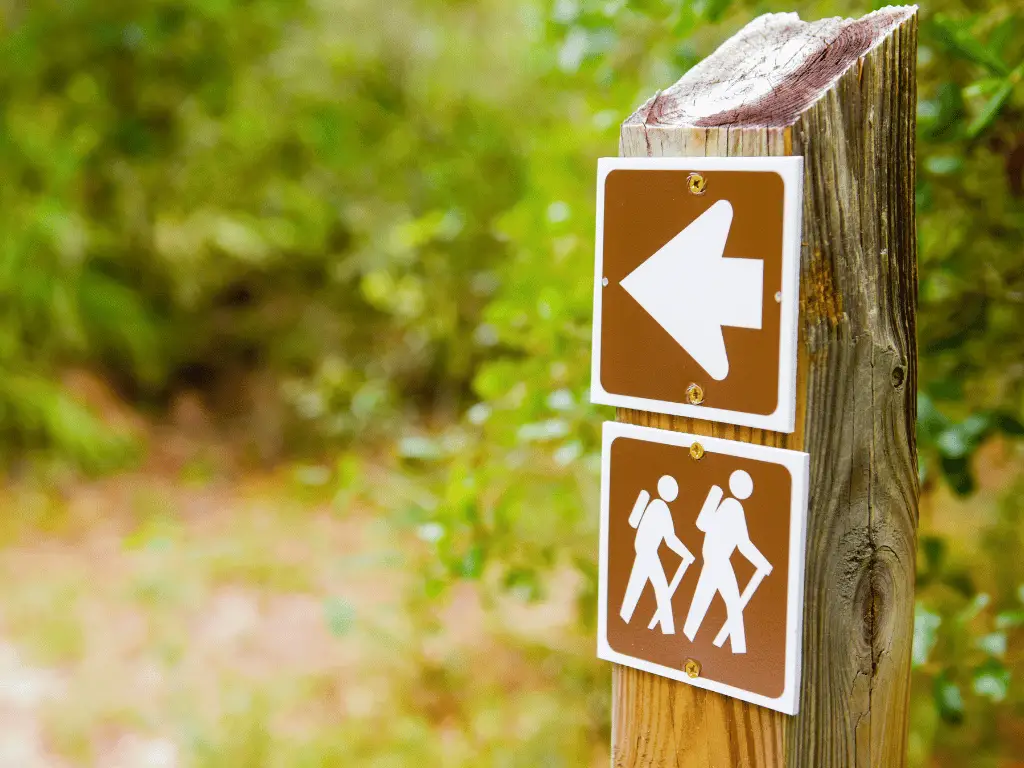
Length and Difficulty
When planning a hike in the rain, choosing a trail with a length and difficulty level that matches your fitness level and skill set is essential. A shorter, less challenging hike may be more appropriate for beginners or those who prefer a gentler experience.
In contrast, a longer, more strenuous hike may be better suited for experienced hikers looking for a challenge.
Consider how much time you have available and what your physical abilities are before choosing a trail. A long and challenging route can lead to fatigue quicker, injury or other problems, especially in wet or slippery conditions.
Moreover, some routes may be closed in rainy weather for safety reasons, so check for any such instructions before heading out.
While aiming for the most challenging hike possible is tempting, it’s essential to factor in the weather conditions. Even an easy hike can become more complicated in rainy weather if the path is slippery or muddy.
Trail Surface and Drainage
Now that you’ve considered the length and difficulty level of the trail, it’s vital to examine the surface and drainage conditions. The terrain on a trail can vary widely, from rocky to smooth, dry to wet. Choosing one with proper drainage can make all the difference regarding safety and enjoyment.
In wet weather, a trail with poor drainage can quickly become a quagmire, making it difficult to navigate, not to mention dangerous. Paths with proper drainage will be clear of standing water and mud, making for a more stable and comfortable hike.
Additionally, the surface of the trail is another crucial factor to consider. A rough and rocky trail can be tricky to navigate, particularly in wet or slippery conditions. A smoother surface, on the other hand, can help you maintain your footing and move more quickly through the terrain.
As you plan your hiking trip, take the time to research the surface and drainage of the trails you’re considering. Talking to a local guide or ranger can help determine which trails best suit your skill level and current weather conditions.
Considering the trail surface and drainage is another part of planning a successful hiking excursion in the rain.
Avoiding Crowded Trails
Overcrowded routes can be frustrating and increase the likelihood of accidents and injuries. How can you avoid them?
If you can adjust your schedule, hiking during off-peak times like weekdays or early mornings can be a great way to enjoy solitude on the trails.
Another way to avoid crowded trails is to research ahead of time and choose lesser-known tracks. Many popular national parks and tourist destinations have hidden gems that are less crowded but equally beautiful.
Talking to locals or joining hiking groups online can also provide valuable insight into hidden trails in your area.
Ultimately, avoiding crowded trails comes down to proper planning. Take the time to research your options and plan accordingly and your reward with a safe and enjoyable wet weather hike.
3. Wear Appropriate Clothing When Hiking in the Rain
When hiking in the rain, wearing appropriate clothing is vital. Not only does it keep you dry and comfortable, but it also helps to protect against the cold. A good rule of thumb is to dress in layers, which allows you to adjust your temperature as needed.
Start with a base layer of moisture-wicking material, such as synthetic fabrics or wool. Such garments help to pull moisture away from your skin, keeping you dry and warm. Avoid cotton as it retains moisture, which can cause chafing and discomfort.
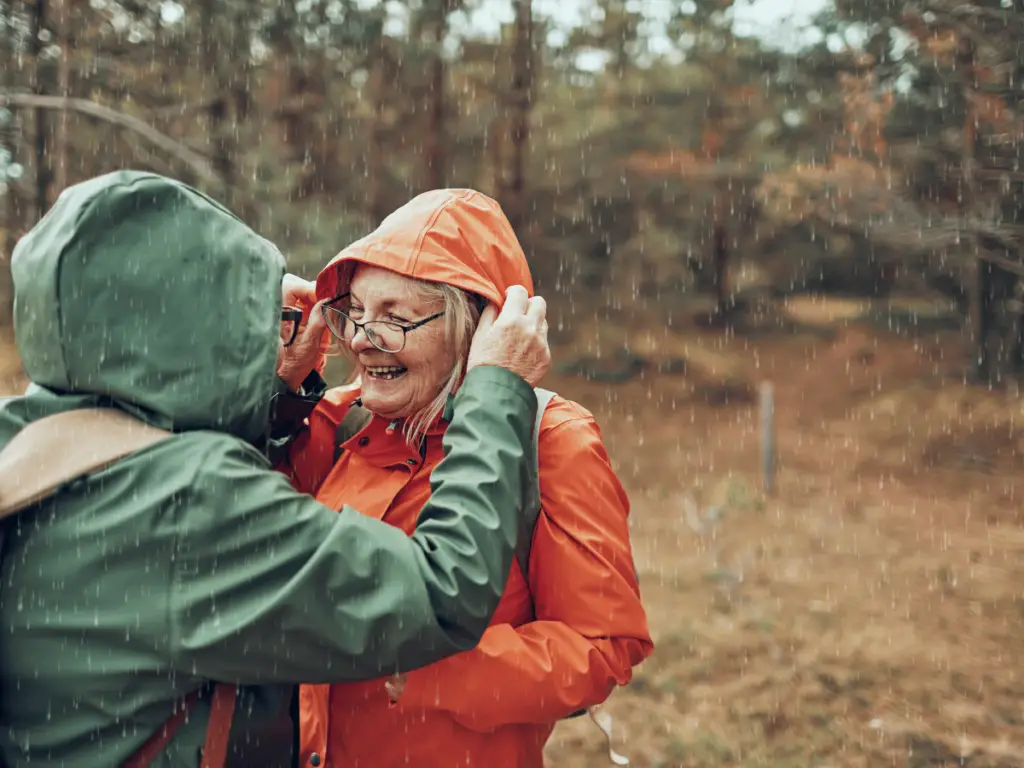
Next, add an insulating layer, such as a fleece or down jacket. This layer helps to trap heat close to your body and keep you warm. Consider adding a windbreaker or waterproof jacket as an outer layer.
Remember your extremities by wearing waterproof and insulated gloves, as well as waterproof and supportive hiking boots. Good boots help keep your feet dry and provide traction on wet and slippery surfaces.
You will handle the challenges of hiking in the rain by wearing appropriate clothing. And once you’ve got your attire sorted, it’s time to turn your attention to keeping the contents of your backpack free of water.
Buy Waterproof Hiking Jackets on Amazon
4. Protect Your Gear
Protecting your gear is the next stage in preparing for wet weather hiking. Wet gear can weigh you down and make your hike uncomfortable and difficult.
Make sure to use waterproof bags or covers for your backpack and any electronics or other important items that you’re carrying.
It’s also a good idea to bring a spare set of dry clothes in case you get wet. These extra measures ensure you and your gear complete the hike.
Buy Waterproof Backpack Covers on Amazon
5. Stay Safe on the Trail
While hiking in the rain can be beautiful and peaceful, it can also have hidden dangers. You must know your surroundings and watch your footing to stay safe. Wet rocks and roots can be slippery, so take your time and step carefully. It’s also a good idea to check weather conditions before heading out.
In addition to watching your footing, it’s crucial to stay on marked trails and avoid any areas that may be prone to flash flooding. Bringing a map and compass is also good if you need help or direction.
By staying aware of your surroundings and taking proper precautions, you can enjoy a safe and enjoyable hike in the rain.
6. Stay Hydrated and Fuelled
Taking care of your body is essential to truly enjoy a hike in the rain, meaning staying hydrated and fuelled throughout your journey.
While it may not be as hot as a sunny day, hiking in the rain can cause dehydration. Bring enough water and electrolyte replacements to keep your body hydrated.
In terms of fuel, it’s important to bring snacks that are both nutritious and energising. Granola bars, nuts, and dried fruits are great options for maintaining your energy levels on the trail.
It’s also important to remember to eat regularly throughout the hike, helping fuel your body and keep you from feeling sluggish.
Taking care of your body this way will allow you to enjoy your hike in the rain fully. Your body will thank you for it.
Buy Hiking Energy Snacks on Amazon
7. Take Breaks When Needed
In addition to staying hydrated and nourished, taking necessary breaks is vital during your rainy hike. Although you may try and power through the inclement weather, occasional pauses to rest and recharge will help you maintain your energy levels and stay safe on the trail.
During your breaks, you can take the opportunity to adjust any wet clothing or gear, stretch out any sore muscles, and assess your overall comfort level.
If you feel like you’re pushing yourself too hard or starting to feel fatigued, take an extended break to catch your breath and let your body recuperate, helping to avoid overexertion or injury in the long run.
By caring for your body with proper fuel and adequate rest, you’ll be better equipped to handle the challenges of hiking in the rain.
8. Be Aware of Hypothermia
By caring for your body with proper fuel and adequate rest, you will better handle the challenges of hiking in the rain. However, hypothermia can still be a risk even with the best preparation.
Hypothermia occurs when your body loses heat faster than it can produce, causing a dangerous drop in body temperature. Such symptoms can occur if you are poorly prepared for hikes in wet and cold conditions.
The warning signs of hypothermia include shivering, confusion, drowsiness, slurred speech, and loss of coordination. If you or anyone in your group starts to show symptoms, it’s important to take action promptly.
Get out of the rain and wind, find shelter if possible, remove any wet clothing and replace it with dry layers, and consume warm liquids or food if available. Time is of the essence, as hypothermia can quickly become life-threatening.
Knowing the symptoms and risks of hypothermia are essential when hiking in the rain, and this knowledge can help you prevent this dangerous condition from developing.
9. Embrace the Experience of Rainy Hikes
Don’t let the risks deter you from embracing a wonderful hiking experience in the rain, as proper preparation and mindset can result in a beautiful and rewarding experience.
Remember to slow down and take in your surroundings, appreciate how the rain transforms the landscape, and relish in the sense of accomplishment once you reach your destination.
It’s a unique and beautiful way to explore nature; you can enjoy every moment with the right mindset.
10. Keep Your Feet Dry When Hiking in the Rain
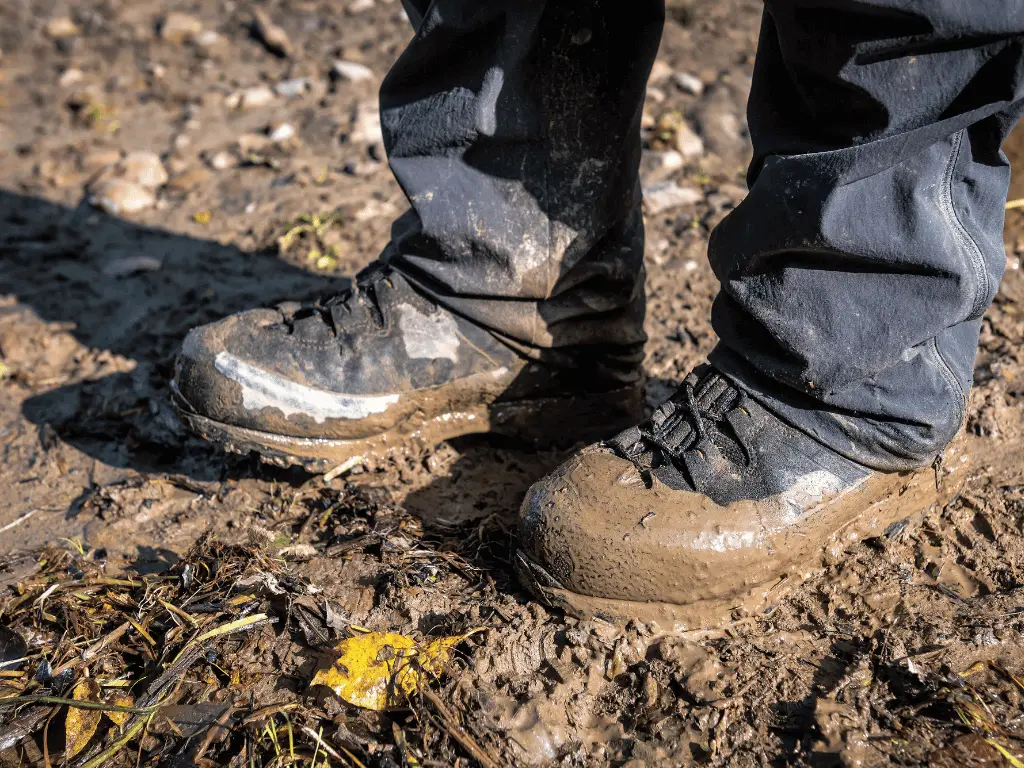
One of the biggest challenges of hiking in the rain is keeping your feet dry. Wet feet can make the hike uncomfortable and lead to blisters or other foot injuries. Here are a few tips to help you avoid wet feet:
Invest in waterproof boots: A good pair will make all the difference. Look for boots with Gore-Tex or other waterproof systems, and make sure they fit well and are comfortable to wear.
Good boots may cost you a hefty sum, but you will thank yourself in the long run for this valuable investment.
Wear gaiters: Gaiters are a great way to keep water and mud from getting inside your boots. They cover the area between your boots and trousers, forming a barrier against water, mud, and other debris.
Bring extra socks: Even with waterproof boots and gaiters, your feet may still get wet. Wet socks can lead to blisters, so keeping your feet as dry as possible is essential. Bring extra socks and change them if your feet start to feel damp.
By keeping your feet dry and comfortable, you can focus on enjoying the scenery and the experience of your wet weather hike.
Buy Waterproof Hiking Boots on Amazon
11. Use Trekking Poles When Wet-Weather Hiking
By now, you know that hiking in the rain requires some extra steps to ensure a comfortable and safe experience. One of the best investments you can make for your rainy hikes is a good pair of trekking poles.
Trekking poles provide stability and support on slippery terrain, reducing the risk of falls and injuries. They also help distribute the weight of your backpack and ease the strain on your knees, particularly when going downhill. Additionally, you can use them to clear away obstacles in your path, such as branches or rocks.
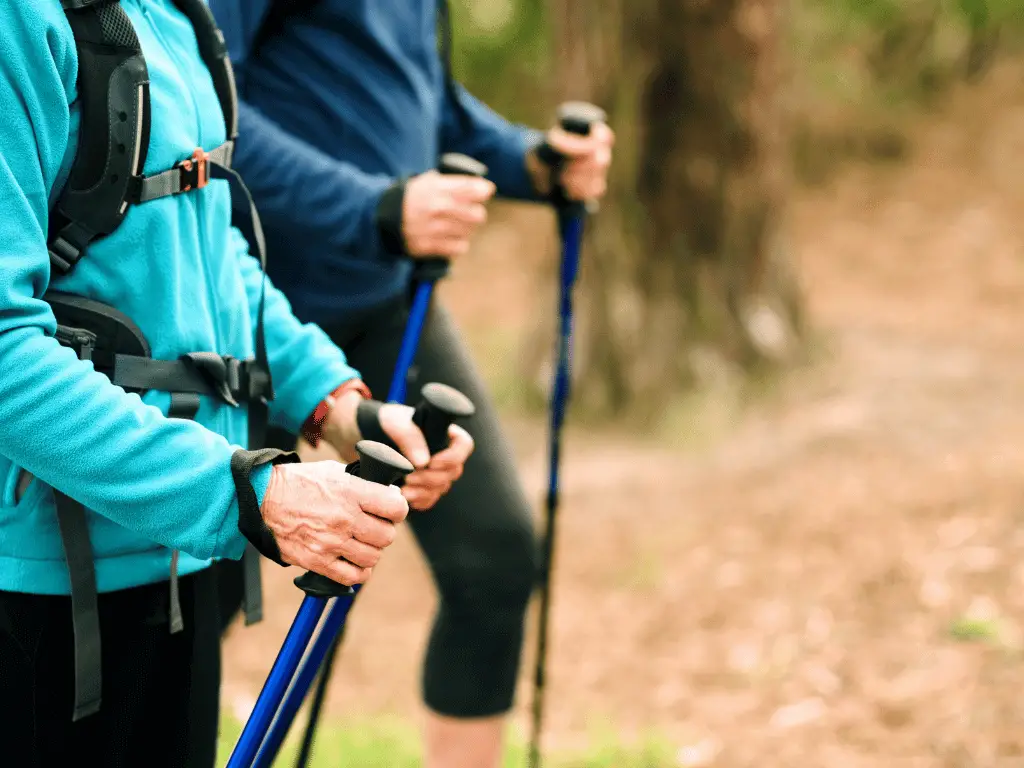
When choosing trekking poles, look for adjustable varieties. Some poles even have interchangeable tips, such as rubber for asphalt and mud and carbide for snow and ice. Make sure to test the straps and grips for comfort and durability.
Using trekking poles may take some practice, but once you get the hang of it, you will want to hike with them. They provide a valuable layer of safety and comfort, allowing you to fully immerse yourself in the rainy wilderness’s sights, sounds, and smells.
Buy Trekking Poles on Amazon
Tips for Hiking in the Rain – Conclusion
Hiking in the rain doesn’t have to be a miserable experience. You can turn a dreary day into an unforgettable adventure with the proper preparation and mindset.
Pay close attention to the tips covered in this article, allowing you to embrace the experience, connect with nature and uniquely challenge yourself.
So, the next time it rains, don’t stay inside—grab your rain gear, hit the trail, and explore the beauty of nature in a different light. As the saying goes, “There’s no such thing as bad weather, only unsuitable clothing.”
Like Our Article? Please Pin it!
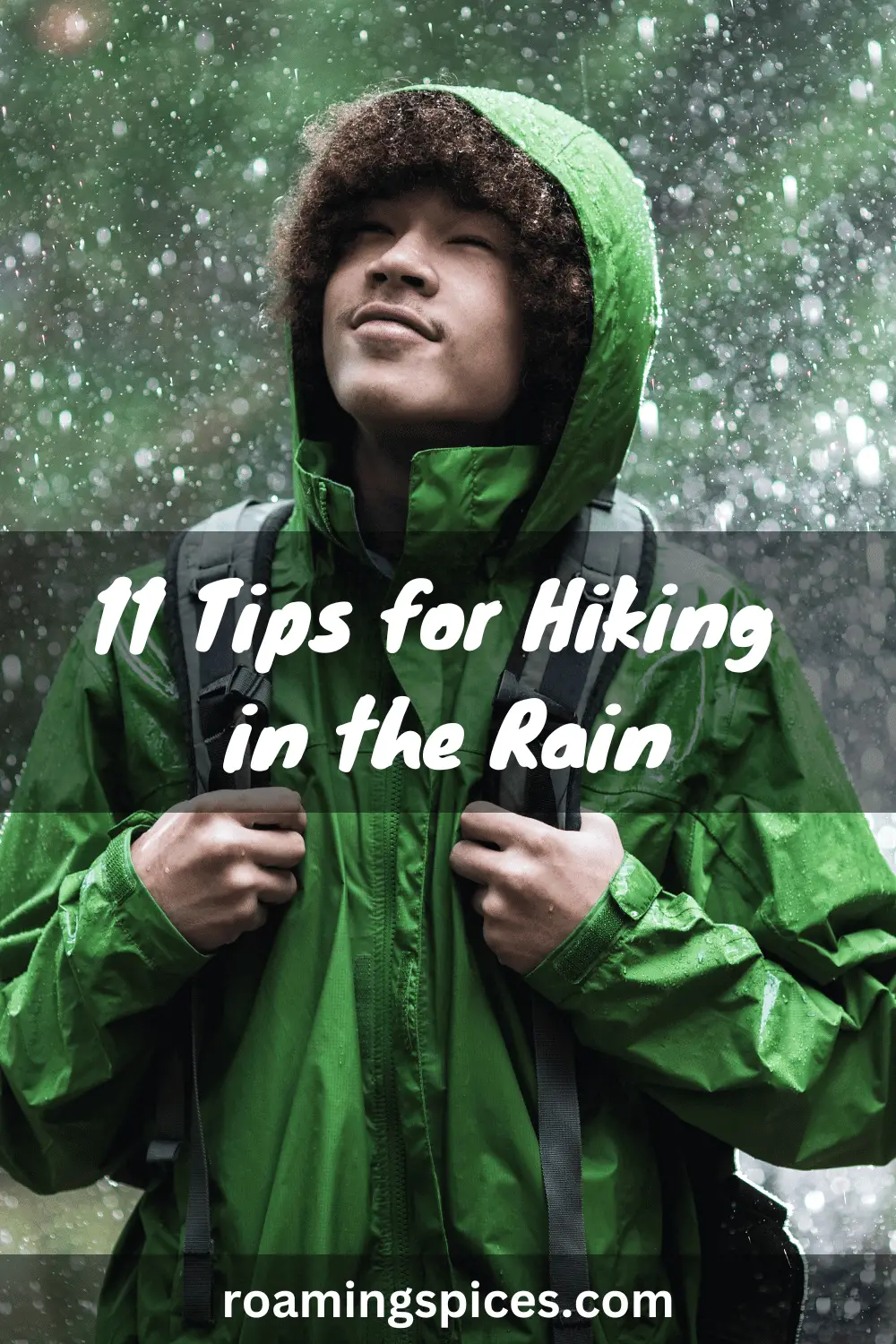

Leave a Reply